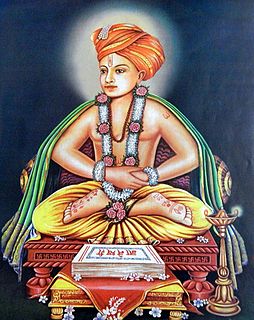
Sant Dnyaneshwar, also referred to as Jnaneshwar, Jnanadeva, Dnyandev or Mauli (1275–1296) was a 13th-century Indian Marathi saint, poet, philosopher and yogi of the Nath Vaishnava tradition. In his short life of 21 years, he authored Dnyaneshwari and Amrutanubhav. These are the oldest surviving literary works in the Marathi language, under the patronage of the Yadava dynasty of Devagiri, and these are considered to be milestones in Marathi literature. Sant Dnyaneshwar's ideas reflect the non-dualistic Advaita Vedanta philosophy and an emphasis on Yoga and oneness of Vishnu and Shiva, but an ardent devotee of Lord Vitthal of Pandharpur. His legacy inspired saint-poets such as Eknath and Tukaram, and he has been regarded as one of the founders of the Varkari (Vithoba-Krishna) Bhakti movement tradition of Hinduism in Maharashtra.Saint Dnyaneshwar disappeared in 1296.

Tukaram was a 17th-century Marathi poet and sant, popularly known as Tuka, Tukobaraya, Tukoba in Maharashtra. He was a Sant of Varkari sampradaya in Maharashtra, India. He was part of the egalitarian, personalized Varkari devotionalism tradition. Sant Tukaram Maharaj is best known for his devotional poetry called Abhanga and community-oriented worship with spiritual songs known as kirtans. His poetry is devoted to Vithoba, also known as Pandurang.

Namdev Ji, also transliterated as Nam Dayv, Namdeo, Namadeva, was an Indian poet and saint from Narsi, Hingoli, Maharashtra India within the Varkari tradition of Hinduism. He lived as a devotee of Lord Vitthal (Krishna) of Pandharpur.
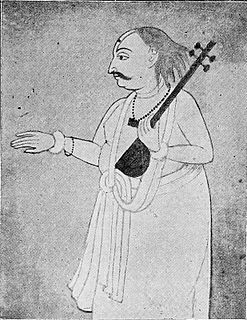
Mahipati was an 18th century Marathi language hagiographer who wrote biographies of prominent Hindu Vaishnava sants who had lived between the 13th and the 17th centuries in Maharashtra and other regions of India.

Warkari is a sampradaya within the bhakti spiritual tradition of Vaishnavite Hinduism, geographically associated with the Indian state of Maharashtra. Warkaris worship Vitthal, the presiding deity of Pandharpur, regarded as a form of Krishna. Saints and gurus of the bhakti movement associated with the Warkaris include Dnyaneshwar, Namdev, Chokhamela, Eknath, and Tukaram, Gadge Maharaj all of whom are accorded the title of Sant.
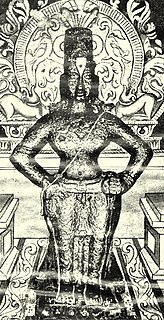
Vithoba, also known as Vi(t)thal(a) and Panduranga, is a Hindu deity predominantly worshipped in the Indian state of Maharashtra. He is generally considered as a manifestation of the god Vishnu or his avatar, Krishna. Vithoba is often depicted as a dark young boy, standing arms akimbo on a brick, sometimes accompanied by his main consort Rakhumai.

Pundalik or Pundarik is a central figure in the legends of the Hindu God Vithoba, generally considered a Vaishnava deity identified with the deities Vishnu and Krishna. He is credited to have brought Vithoba to Pandharpur, where Vithoba's central shrine stands today. Pundalik is also perceived to be the historical founder of the Varkari sect, which is centered on the worship of Lord Vithoba.
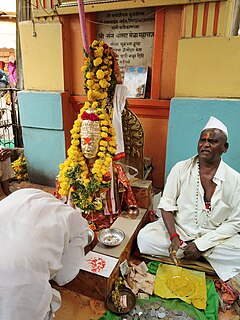
Chokhamela was a saint in Maharashtra, India in the 14th century. He belonged to the Mahar caste, one of the untouchable castes in India. He was born at Mehuna Raja, a village in Deulgaon Raja Taluka of Buldhana district. He lived at Mangalvedha in Maharashtra. He wrote many Abhangas. He was one of the first low-cast poets in India. Chokhamela lived with his wife Soyarabai and son Karmamela in Mangalvedha. Chokhamela's task was to guard and work in farms of upper caste people.

Abhang or abhanga is a form of devotional poetry sung in praise of the Hindu god Vitthal, also known as Vithoba. The word "abhang" comes from a for "non-" and bhang for "ending" or "interrupting", in other words, a flawless, continuous process, in this case referring to a poem. By contrast, the devotional songs known as Bhajans focus on the inward journey. Abhangs are more exuberant expressions of the communitarian experience. Abhanga is considered a form of the ovi. Abhangs are sung during pilgrimage to the temples of Pandharpur, by the devotees.
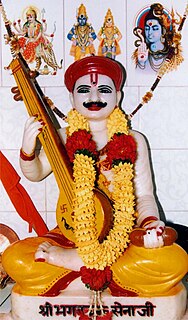
Sena Nhavi, also known as Sain Sena,Sena, is a Hindu saint-poet (sant-kavi) of the Varkari sect dedicated to the god Vithoba.in Marathi

The Vithoba Temple, officially known as Shri Vitthal-Rukmini Mandir (Marathi: श्री विठ्ठल-रूक्मिणी मंदिर, Kannada: ಶ್ರೀ ವಿಠ್ಠಲ - ರುಕ್ಮಿಣೀ ಮಂದಿರ is a Hindu temple in Pandharpur in the Indian state of Maharashtra. It is the main centre of worship for Vithoba, a form of the god Vishnu or Krishna, and his consort Rakhumai. It is the most visited temple in Maharashtra. The Warkaris start marching from their homes to the temple of Pandharpur in groups called Dindi to reach on Aashadhi Ekadashi and Kartiki Ekadashi. A dip in the holy river Chandrabhaga, on whose banks Pandharpur resides, is believed to have power to wash all sins. All the devotees are allowed to touch the feet of the idol of Vithoba. In May 2014, the temple became the first in India to invite women and people from backward classes as priests.
Visoba Khechara, spelled also as Visoba Khechar or Visoba Khecar, was the yogi-guru of the Varkari poet-saint Namdev (c.1270-1350) of Maharashtra, India. Visoba was a disciple of the Varkari poet-saint Jñāneśvar. He had linkages with the Varkari tradition as well as the Nath tradition of Maharashtra. Though a staunch Shaiva, Visoba has composed verses in praise of the god Vithoba, the patron deity of the Varkari faith. He has also composed a metaphysical treatise called the Shatsthala.
Bahinabai or Bahina or Bahini is a Varkari female-saint from Maharashtra, India. She is considered as a disciple of another Varkari poet-saint Tukaram. Having been born in a Brahmin family, Bahinabai was married to a widower at a young age and spent most of her childhood wandering around Maharashtra along with her family. She describes, in her autobiography Atmamanivedana, her spiritual experiences with a calf and visions of the Varkari's patron deity Vithoba and Tukaram. She reports being subjected to verbal and physical abuse by her husband, who despised her spiritual inclination but who finally accepted her chosen path of devotion (bhakti). Unlike most female-saints who never married or renounced their married life for God, Bahinabai remained married her entire life.
Kanhopatra was a 15th-century Marathi saint-poet, venerated by the Varkari sect of Hinduism.
Bir Kuar or Birkuar, also known as Birnath, is a Hindu cattle-god worshipped by Yadavs of western Bihar in India. He is considered to be a form of god Krishna and was born in Krishnaut clan. He is worshipped in form of wooden posts that depict him standing arms-akimbo. Bir Kuar is honoured as the protector of cattle and the god who infuses fertility in cattle.
Muktabai or Mukta was a saint in the Varkari tradition. She was born in a Deshastha Brahmin family and was the younger sister of Dnyaneshwar, the first Varkari saint. Muktabai wrote forty-one abhangs throughout her life span.
Bhanudasa (1448–1513), was a Hindu sant who brought back the sacred image of the god Vithoba back from Vijayanagara to Pandharpur, its original location. He was Eknath’s great grandfather. As a boy he worshipped the Sun but later came to worship Vithoba. He is the subject of two chapters in the Bhaktavijaya. His Samadhi situated in solkhambi mandap of Vitthal temple at Pandharpur.

Sant Tukaram, also known as Saint Tukaram, is a 1936 Marathi film, produced by Prabhat Film Company and based on the life of Tukaram (1608–50), a prominent Varkari saint and spiritual poet of the Bhakti movement in India. The film was directed by Vishnupant Govind Damle and Sheikh Fattelal and featured Vishnupant Pagnis in the lead role of the saint.
Narahari Sonar or Narhari Sonar is a 13th-century Hindu poet-saint of the Varkari sect and goldsmith (sonar) from Maharashtra, India. His hagiography speaks about his transition from a staunch Shaiva to a Vithoba-worshipping Varkari after a miracle that makes him realize that Vithoba and Shiva are one and the same.

Pandharpur Wari or Wari pronounced vaaree, is an annual pilgrimage (yatra) to the town of Pandharpur, which is the seat of Hindu God Vithoba in the Indian state of Maharashtra, in honour of the deity. Palakhis carrying the paduka of the deity and various saints, most notably Dnyaneshwar and Tukaram from the Warkari sect, are taken from their respective shrines to Pandharpur. Warkari is a Marathi term which means "one who performs the Wari" or "one who venerates the Vithoba". The tradition is more than 700 to 800 years old.












